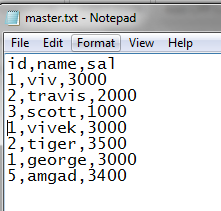Python | Write multiple files data to master file
Last Updated :
06 May, 2019
Given a number of input files in a source directory, write a Python program to read data from all the files and write it to a single master file.
Source directory contains n number of files, and structure is same for all files. The objective of this code is to read all the files one by one and then append the output into a single master file having structure same as source files.
Taking three input files as example, named emp_1.txt, emp_2.txt, emp_3.txt, output will contain data from all the input files.
Input:


 Output:
Output:

Method #1: Using os module
import os
lis = os.listdir('D:\\python'
'\\data_files\\data_files')
print(lis)
tgt = os.listdir('D:\\python'
'\\data_files\\target_file')
file_dir ='D:\\python\\data_files\\data_files'
out_file = r'D:\\python\\data_files\\target_file\\master.txt'
ct = 0
print('target file :', tgt)
try:
if len(tgt)>0:
os.remove('D:\\python'
'\\data_files\\target_file\\master.txt')
open(tgt, 'a').close()
else:
open(tgt, 'a').close()
except:
head = open('D:\\python'
'\\data_files\\target_file\\master.txt', 'a+')
line ='empno, ename, sal'
print(head, line)
head.close()
for line1 in lis:
f_dir = file_dir+'\\'+line1
in_file = open(f_dir, 'r+')
w = open(out_file, 'a+')
d = in_file.readline()
d = in_file.readlines()
w.write("\n")
for line2 in d:
print(line2)
w.write(line2)
ct = ct + 1
w.close()
|
Output:

Method #2: Using pandas
import pandas as pd
df1 = pd.read_csv('D:\python\data_files\data_files\emp_1.txt')
df2 = pd.read_csv('D:\python\data_files\data_files\emp_2.txt')
df3 = pd.read_csv('D:\python\data_files\data_files\emp_3.txt')
frames = [df1, df2, df3]
result = pd.concat(frames)
result.to_csv('D:\\python\\data_files'
'\\target_file\\master.txt', encoding ='utf-8', index = False)
|
Output:

Share your thoughts in the comments
Please Login to comment...